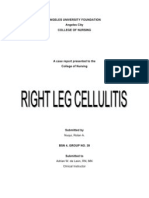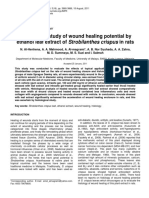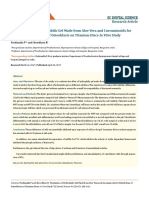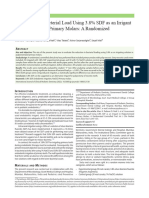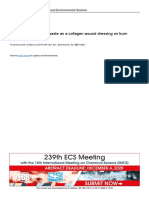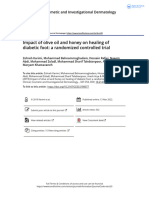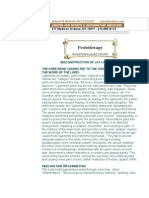3-XD20 1273 Yosaphat Bayu Rosanto Indonesia
3-XD20 1273 Yosaphat Bayu Rosanto Indonesia
Uploaded by
muharrimah rimaCopyright:
Available Formats
3-XD20 1273 Yosaphat Bayu Rosanto Indonesia
3-XD20 1273 Yosaphat Bayu Rosanto Indonesia
Uploaded by
muharrimah rimaOriginal Description:
Original Title
Copyright
Available Formats
Share this document
Did you find this document useful?
Is this content inappropriate?
Copyright:
Available Formats
3-XD20 1273 Yosaphat Bayu Rosanto Indonesia
3-XD20 1273 Yosaphat Bayu Rosanto Indonesia
Uploaded by
muharrimah rimaCopyright:
Available Formats
Journal of International Dental and Medical Research ISSN 1309-100X Effectiveness of Kirinyuh Extract
http://www.jidmr.com Elok Riski Wulandari and et al
Effectiveness of Kirinyuh (Chromolaena Odorata) Extract on Increasing of Collagen Fibers
after Tooth Extraction
Elok Riski Wulandari1, Juni Handajani2, Yosaphat Bayu Rosanto3
1. Graduate Student, Faculty of Dentistry, Universitas Gadjah Mada.
2. Doctor of Oral Biology, Vice Dean of Faculty of Dentistry, Universitas Gadjah Mada.
3. Master of Dental Science, Oral and Maxillofacial Surgeon, Faculty of Dentistry, Universitas Gadjah Mada.
Abstract
Tooth extraction is procedure of removing a tooth from the socket. Kirinyuh leaves
(Chromolaena odorata) contain flavonoids, saponins, and tannins that can help in the wound-
healing process after tooth extraction. This study aimed to determine the effect of applying kirinyuh
leaf ethanol extract on the density of collagen fibers in the wound after tooth extraction in guinea
pigs.
Sixty male guinea pigs (Cavia cobaya) were divided into five groups: negative control, positive
control, and treatment groups with kirinyuh leaf ethanol extract concentrations of 2.5%, 5%, and
10%. Extracts of kirinyuh leaf were made as topical products. Subjects’ teeth were extracted on the
same day, and extract of kirinyuh leaves was applied topically on the wound. Subjects were
euthanized, and histopathological specimens were obtained on days 3, 7, 10, and 14 after tooth
extraction, subjected to Mallory trichrome staining, and then observed under a microscope. The
treatment groups had higher density of collagen fibers than the controls. Statistical analysis showed
significant differences in all groups and days.
In conclusion, the ethanol extract of kirinyuh leaves can increase the density of collagen fibers
in post-tooth extraction wounds, and 10% kirinyuh leaf extract has the highest rate of increasing
collagen fiber density.
Experimental article (J Int Dent Med Res 2020; 13(4): 1258-1263)
Keywords: Tooth extraction, Kirinyuh extract, density of collagen fiber, wound healing, Cavia
cobaya, Mallory.
Received date: 03 September 2020 Accept date: 18 October 2020
Introduction matrix, and soluble mediators such as growth
factors and cytokines4. Collagen is an essential
Tooth extraction is conducted in certain protein that connects cells and has a central role
cases, for example, the tooth cannot be in the production of extracellular matrix that
maintained anymore, irritates surrounding teeth, strengthens tissues and closes the wound 5,6.
or affects other organs. Healthy teeth may be For centuries, Indonesians have used
extracted for orthodontic treatment. Tooth medicinal plants to overcome health problems 7,
extraction leaves a wound and may cause such as kirinyuh (siam weed or Chromolaena
complications such as bleeding, pain, infection, odorata), which is a tropical plant from the
and dry socket1. Asteraceae family. Although this plant is often
Wound healing is the process by which considered harmful as a weed, some regions in
damaged tissues recover its normal condition 2. Indonesia, especially the Acehnese people,
The wound-healing process may occur utilize kirinyuh as a medicine, especially to treat
chemically and naturally3. Wound healing wound8. Its saponin content may boost collagen
involves numerous cell populations, extracellular production, while its tannin and flavonoid
components act as antiseptic and antibacterial
*Corresponding author:
agents9,10. Thus, this study aimed to compare the
Yosaphat Bayu Rosanto, DDS, MDSc., OMFS density of collagen fibers after tooth extraction in
Departement of Oral and Maxillifacial Surgery, guinea pigs (Cavea cobaya) using 2.5%, 5%, and
Faculty of Dentistry, Universitas Gadjah Mada, 10% kirinyuh leaf ethanol extracts.
55281, Yogyakarta, Indonesia
E-mail: yosaphatbr@ugm.ac.id
Volume ∙ 13 ∙ Number ∙ 4 ∙ 2020 Page 1258
Journal of International Dental and Medical Research ISSN 1309-100X Effectiveness of Kirinyuh Extract
http://www.jidmr.com Elok Riski Wulandari and et al
Materials and methods fibers; 1, collagen fiber density <50%, absence of
fibers to the less dense tissue structure, there are
Production of kirinyuh leaf extract many cells, vascularity, and mononuclear cells; 3,
The first step was the production of kirinyuh collagen fiber density >50%, with a denser tissue
leaf powder. This process started with washing structure, absence or slight inflammatory
destemmed kirinyuh leaves with water and then reaction; and 5, normal collagen fibrous density
finely slicing them before drying under shade. (avascular and acellular).
Then, the dried kirinyuh leaves were ground
using a blender until they turned into powder.
Thereafter, 70% ethanol extract was produced
through maceration. Liquid preparation was
produced by extracting the vegetal ingredients
that had been soaked in 70% ethanol. After 3
days, it was filtered using a filter paper to obtain Figure 1. Collagen density score from lowest to
the filtrate from which the solvent was highest density (from left to right: scores 1, 2, and
evaporated using rotary vacuum evaporator in 3)[24].
500°C temperature. Finally, kirinyuh leaf ethanol
extract was obtained. Statistical analysis
Treatment on the experimental animals The observation result data were ordinal
Sixty male guinea pigs (Cavia cobaya), aged scale data and analyzed using Kruskal–Wallis
9–10 weeks and weighed 300–350 grams, were tests to know the influence of the number of days
used as experimental subjects. We got guinea and concentration on collagen production, and
pigs from our university's Integrated Research Mann–Whitney tests were used to see the
Laboratory. Guinea pigs were first acclimated for difference between groups. All data were
7 days in cages. Individual cages measuring 30 x analyzed using SPSS software (IBM Corp.,
40 x 15 cm were given to each guinea pigs with a Armonk, NY).
dry bush base and cleaned every day. Guinea
pigs were fed with standard foods such as pellets, Results
leaves and water ad libitum. Ethical clearance
was obtained from the Medical Research Ethics
Commission of the Faculty of Dentistry,
Universitas Gadjah Mada.
Tooth extraction was done on the
mandibular first incisor. After the extraction,
kirinyuh leaf ethanol extract was applied on the
sockets of the treatment group once a day. The
subjects were divided into five groups: negative
control group, positive control group, and
treatment groups with kirinyuh leaf ethanol
extract concentrations of 2.5%, 5%, and 10%.
The guinea pigs were euthanized on day 3, 7, 10,
and 14 after treatment, with three guinea pigs in Figure 2. Mean of collagen fiber density.
each treatment group and control group. The
mandibles were extracted and sterilized using Figure 2 shows that the means of collagen
0.9% NaCl and histologically by Mallory staining. fiber density on the tooth socket alveolar bones
To calculate the collagen fiber density, three in the negative control, positive control, and 2.5%,
investigators observed the preparations at 400× 5%, and 10% treatment groups were increasing
magnification under a microscope. Collagen fiber from the day 3 until 14. Marked increase in the
density data were averages from six different means of collagen fiber density can be seen
fields of view. The observation score of collagen particularly in the 10% treatment group. Among
fiber density was determined by using an ordinal the groups, 10% kirinyuh leaf ethanol extract on
scale ranging from 0 to 5 11, with the following the tooth socket on days 3, 7, 10, and 14 had the
evaluation criteria (Figure 1): 0, no collagen highest mean collagen fiber density.
Volume ∙ 13 ∙ Number ∙ 4 ∙ 2020 Page 1259
Journal of International Dental and Medical Research ISSN 1309-100X Effectiveness of Kirinyuh Extract
http://www.jidmr.com Elok Riski Wulandari and et al
On Kruskal–Wallis tests, each group
showed significant differences in the density of
the tooth socket collagen fibers on day 3, 7, 10,
and 14 (p = .000) . On the Mann–Whitney tests,
significant differences were found in the density
of collagen fibers between groups during
observation (p < .05). The topical application of
10% kirinyuh leaf ethanol extract in post-
extraction wounds showed earlier formation of
collagen fibers than other extract concentrations
and control.
Discussion
This study showed that all groups Figure 3. Histological comparison of guinea pig’s
underwent significant increase in collagen fiber tooth socket on the apical portion of the socket
density on day 3, 7, 10, and 14 after tooth on day 3 (400× magnification). Collagen appears
extraction. Collagen formation is one of the to have formed in all groups, and the thickest
indicators of the wound-healing process. collagen density is found in the 10% treatment
Collagen plays an active role in the proliferation group. Negative control group (A), positive
phase by increasing the strength of the wound control group (B), 2.5% treatment group (C), 5%
tissue12. Cells that play a role in collagen treatment group (D), and 10% treatment group
formation include fibroblasts and osteoblasts. (E). Bone socket area (a), alveolar bone (b), and
Fibroblasts are mesenchymal cells originating collagen (arrow).
from the walls of the alveolar bone and migrate
and proliferate in the tooth socket. The increase Figure 3 shows the density of collagen
in collagen fiber density started on day 3 after fibers on day 3. Mallory staining shows
wounding11, which coincides with the start of the inflammatory cells and erythrocytes that are
migration and proliferation of fibroblasts. scattered over the wound area. Collagen fibers
Fibroblasts begins to synthesize collagen on day still look very thin and rare. This happens
3 in response to the transforming growth factor because on day 3 there is overlapping between
(TGF-β) mediator. Collagen synthesis will reach the inflammatory phase and the proliferative
its peak on days 5–713. Osteoblasts are cells also phase of the wound-healing process.
derived from mesenchymal cells. Osteoblasts Moreover, on day 3, a significant difference
synthesize collagen and glycosaminoglycans was found between the 2.5%, 5%, and 10%
from the bone matrix and play a role in the bone treatment groups compared with the positive
mineralization process. Osteoblasts secrete control group. These results indicate that the
several chemical compounds including collagen administration of kirinyuh leaf ethanol extract gel
type 1, alkaline phosphatase, osteopontin, and affected the density of collagen fibers after tooth
osteocalcine12. The increase in collagen extraction compared with the positive control
synthesis continues until the second week after group. This finding agrees with the statement of
wounding14. Yenti et al. (2011), who conducted a study of
Kirinyuh leaf extract toxicity tests have been kirinyuh leaf ethanol extract cream with the same
carried out. The observed toxicity parameter was concentration in wounds on the backs of mice15.
lethal dose 50 (LD50). That study aimed to They found that 2.5%, 5%, and 10% ethanol
determine the LD50 value, or a dose that can kill extract cream showed faster wound-healing rate
50% of mice (Mus musculus), and provide a safe than 10% povidone-iodine.
dosage data of kirinyuh leaf extract 3. Common The insignificant results between the 2.5%,
toxic symptoms are diarrhea and urination. In 5%, and 10% kirinyuh leaf extract concentrations
that study, a dose of ethanol extract from kirinyuh on day 3 indicates that the kirinyuh leaf
leaves of 14.1416 g/kg BW or 28.82% is concentrations have almost the same effect on
considered “light toxic”; thus, in the present study, the formation of collagen. The negative control
we used extracts at 2.5%, 5%, and 10%, which group showed a significant difference in collagen
are considered safe. fiber density from the positive control group and
Volume ∙ 13 ∙ Number ∙ 4 ∙ 2020 Page 1260
Journal of International Dental and Medical Research ISSN 1309-100X Effectiveness of Kirinyuh Extract
http://www.jidmr.com Elok Riski Wulandari and et al
all treatment groups. The wound-healing process
in the negative control group is no better than
10% povidone-iodine or kirinyuh leaf extract
because aquades have no other active
component that can help speed up the wound-
healing process.
Figure 6. Histological comparison of guinea pig’s
tooth socket on the apical portion of the socket
on day 14 (400× magnification). Mineralization
appears to have formed in all groups, and the
10% treatment group showed a wider area than
the other groups. Negative control group (A),
positive control group (B), 2.5% treatment group
Figure 4. Histological comparison of guinea pig’s (C), 5% treatment group (D), and 10% treatment
tooth socket on the apical portion of the socket group (E). Bone socket area (a), alveolar bone
on day 7 (400× magnification). Collagen appears (b), and mineralized collagen (arrow).
to have thickened in all groups. Negative control
group (A), positive control group (B), 2.5% Observations on days 7–10 show that all
treatment group (C), 5% treatment group (D), groups had higher collagen fibers than on day 3
and 10% treatment group (E). Bone socket area (Figures 3–6). Fibroblasts start appearing
(a), alveolar bone ( b), and collagen (arrow). significantly for the first time on day 3 and will
reach their peak on day 7 16. Fibroblasts are
deposited in the extracellular matrix in the form of
collagen fibers that will peak on day 7.
Fibroblasts produce large amounts of collagen.
This collagen is in the form of triple glycoprotein,
the main element of extracellular wound matrix
which is very useful for the strength formation of
scar tissue17. Saponin compounds in kirinyuh leaf
ethanol extract may help increase collagen fiber
density by stimulating fibronectin synthesis.
Increasing fibronectin synthesis will accelerate
the migration and proliferation of fibroblasts to
the wound area; thus, the collagen synthesis will
increase10.
In this study, no significant difference was
Figure 5. Histological comparison of guinea pig’s found on day 7 between the 25% treatment
tooth socket on the apical portion of the socket group and positive control group. This occurs
on day 10 (400× magnification). Collagen has because both groups have components that can
partially mineralized into the bone. Negative accelerate wound healing. Povidone-iodine is a
control group (A), positive control group (B), local antibacterial compound that is effective in
2.5% treatment group (C), 5% treatment group killing bacteria and spores and is widely used for
(D), and 10% treatment group (E). Bone socket antiseptics. Povidone-iodine, which is used as a
area (a), alveolar bone ( b), and collagen (arrow). positive control, can kill infection-causing
microorganisms, such as Gram positive bacteria
Volume ∙ 13 ∙ Number ∙ 4 ∙ 2020 Page 1261
Journal of International Dental and Medical Research ISSN 1309-100X Effectiveness of Kirinyuh Extract
http://www.jidmr.com Elok Riski Wulandari and et al
and Gram negative bacteria including spores and function as a protein precipitator and chelating
fungi. Two mechanisms can explain the metal. Tannin is predicted to act as a biological
antimicrobial effect of 10% povidone-iodine: antioxidant24. Saponin may increase the
povidone-iodine can oxidize enzymes for fibroblast’s receptor ability to TGF-β, given the
respiration, and it has antimicrobial effect through ability of fibroblasts to bind with TGF-β.
iodination of amino acids. The iodine content Fibroblasts need TGF-β to synthesize collagen to
prevents bacteria from forming proteins and heal the tooth socket wound10. Saponin has anti-
destroys microorganisms18. Kirinyuh leaf ethanol inflammatory activity by blocking the
extract also contain an antibacterial component, prostaglandin production pathway, resulting in a
that is, saponins. Saponins can increase the decrease in prostaglandin production 25.
permeability of bacterial cell membranes. Decreased production of prostaglandins, an
Permeability is the ability of a substance to allow inflammatory mediator, can ease the vasodilation
passage of particles through it19. When saponins in blood vessels in the local bloodstream so that
and bacteria interact, saponins increase the the migration of inflammatory cells will decrease.
permeability of bacterial cell membranes to allow Decreased number of inflammatory cells and
passage of porous forms in bacterial cells. bacteria causes brief inflammatory phase and
Eventually, the cell will undergo lysis and die immediately initiates the proliferation phase26,27.
following loss of all cell contents that diffuse out This may cause the matrix classification to occur
of the cell20. earlier.
Microscopic observations on day 10 showed Observation on day 14 shows that the
the presence of increasingly dense collagen in all density of collagen fibers treated with 10%
groups. The density of collagen fibers is kirinyuh leaf ethanol extract has the highest
increasing and reaches its peak on day 10 after mean among the groups. Figure 6 shows that
application of kirinyuh leaf ethanol extract. bone mineralization occurred mostly in the tooth
Changes in the density of collagen fibers in the socket wound in the 10% treatment group. On
treatment group show an earlier bone matrix day 14 after tooth extraction, collagen fibers have
formation process marked by the formation of undergone mineralization and reinforcement has
collagen bundles. The maturation of collagen started. On day 14, collagen fibers are ready to
fibers causes an increase in the density of enter the maturation phase. The maturation
collagen fibers in tissues13, 21. The increase in the phase starts 2–3 weeks after wounding. In this
thickness of collagen was attributed to the gel phase, the collagen level is stable between
content of kirinyuh leaf ethanol extract which can deposition and degradation 14,28. Enzymes such
stimulate the formation of collagen, affecting the as matrix metalloproteinase, cysteine proteinase,
proliferation phase after tooth extraction. The and serine proteinase can degrade collagen
content of kirinyuh leaf ethanol extract that can fibers in the alveolar bone. This indicates that the
induce cells that play a role in the healing bone-modeling process is ongoing, which marks
process of wound healing include flavonoids, that first stage of bone regeneration.
saponins, and tannins.
The increase in collagen thickness is
allegedly caused by the contents of kirinyuh leaf Conclusions
ethanol extract that boost collagen production
and affect the proliferation phase in the wound- Topical application of kirinyuh leaf ethanol
healing process after tooth extraction 22. extract can accelerate wound healing, as shown
According to Youngyo et al. (2017), flavonoids by the increase in collagen fibers on the wound
have antioxidant properties, so they can reduce after tooth extraction. The highest increase in
low-density lipoproteins23. Flavonoids also collagen density was observed after the
improve the number of blood vessel endothelial application of 10% kirinyuh leaf ethanol extract.
cells by reducing the risk of blood clots because Thus, 10% concentration of ethanol extract from
of their anti-aggregation properties. Tannin can kirinyuh leaf helps accelerate the wound-healing
be defined as a polyphenol compound with a process since days 3–4 of tooth extraction.
very large molecular weight (>1000 g/mol) and
can form complex compounds with protein.
Tannin has a great biological role because of its
Volume ∙ 13 ∙ Number ∙ 4 ∙ 2020 Page 1262
Journal of International Dental and Medical Research ISSN 1309-100X Effectiveness of Kirinyuh Extract
http://www.jidmr.com Elok Riski Wulandari and et al
Acknowledgements 17. Marcandetti M, Cohen A. Wound Healing, Healing, and Repair.
Emedicine. Available at URL: http//www.eMedicine.com.Inc.
Accessed October 7, 2002.
This research was supported by 18. Stoddard FR, Brooks AD, Eskin BA, Johannes GJ. Iodine Alters
Universitas Gadjah Mada. All authors have made Gene Expression in the MCF7 Breast Cancer Cell Line:
Evidence for an Anti-Estrogen Effect of Iodine. Int J Med Sci
substantive contribution to this study and/or 2008;5(4):189-96.
manuscript, and all have reviewed the final paper 19. Arabski M, Wegierek-Ciuk A, Czerwonka G, Lankoff A, Kaca W.
Effects of Saponins against Clinical E. Coli Strains and
prior to its submission. We thank our colleagues Eukaryotic Cell Line. Journal of Biomedicine and Biotechnology
who provided insight and expertise that greatly 2012;(4):286216
assisted this research. No potential conflict of 20. Stoya G. Hemolysis of human erythrocytes with saponin affects
the membrane structure. Acta Histochemica 2000;102(1):21-35.
interest relevant to this article was reported. 21. Vieira CP, de Oliveira LP, Guerra FD, de Almeida MDS,
Marcondes MCCG, Pimentel ER. Glycine Improves Biochemical
Declaration of Interest and Biomechanical Properties Following Inflammation of the A
chilles Tendon. The Anatomical Record 2014;298(3):538-45.
22. Phan TT, Hughes MA, Cherry GW, Le TT, Pham HM. An
The authors report no conflict of interest. aqueous extract of the leaves of Chromolaena odorata
(formerly Eupatorium odoratum) (Eupolin) inhibits hydrated
collagen lattice contraction by normal human dermal fibroblasts.
References J Altern Complement Med 1996;2(3):335-43.
23. Youngyo K, Youjin J. Flavonoid intake and mortality from
1. Taiwo AO, Ibikunie AA, Braimah RO, Sulaiman OA, Gbotolorun cardiovascular disease and all causes: A meta-analysis of
OM. Tooth extraction: pattern and etiology from extreme prospective cohort studies. Clinical Nutrition ESPEN
Northwestern Nigeria. Eur J Dent 2017;11(3):335-9. 2017;20:68-77.
2. Gonzales ACO, Costa TF, Andrade ZA, Medrado ARAP. 24. Adamczyk B, Simon J, Kitunen V, Adamczyk S, Smolander A.
Wound healing – A literature review. An Bras Dermatol Tannins and Their Complex Interaction with Different Organic
2006;91(5):614-20. Nitrogen Compounds and Enzymes: Old Paradigms versus
3. Guo S, DiPietro LA. Factors affecting wound healing. J Dent Recent Advances. Chemistry Open 2017;6(5):610–14.
Res 2010; 89(3):219-29. 25. Jang KJ, Kim HK, Han MH, Oh YN, Yoon HM, Chung YH, Kim
4. Vital PG, Rivera WL. Antimicrobacterial Activity and Citoxicity of GY, Hwang HJ, Kim BW, Choi YH. Anti-inflammatory effects of
Chromolaena Odorata (L.F) King and Robinson and Uncaria saponins derived from the roots of Platycodon grandiflorus in
Perrottetii (A. Rich) Merr. Extracts, Available Online. J Med lipopolysaccharide‑stimulated BV2 microglial cells. Int J
Plant Res 2009;3(7):511-8. Molecular Med 2013;31(6):1357-66.
5. Shoulders MD, Raines RT. Collagen structure and stability. 26. Soeroso Y, Bachtiar EW, Boy BM, Sulijaya B, Prayitno SW. The
Annu Rev Biochem 2009;78:929-58. Prospect of Chitosan on The Osteogenesis of Periodontal
6. Song H, H, Zhang S, Zahng L, Li B. Effect of orally Ligament Stem Cells. J Int Dent Med Res 2012;5:(2):93-7.
administered collagen peptides from bovine bone on skin aging 27. Abdulkhaleq LA, Assi MA, Abdullah R, Zamri-Saad M, Taufiq-
in chronologically aged mice. Nutrients 2017;8(11):1209-11. Yap YH, Hezmee MNM. The crucial roles of inflammatory
7. Sholikhah EN. Indonesian medicinal plants as sources of mediators in inflammation: A review. Vet World 2018;11(5):627-
secondary metabolites for pharmaceutical industry. J Med Sci 35.
2016;48(4):226-39. 28. Khoswanto C, Soehardjo I. The effect of Binahong Gel
8. Vijayaraghavan K, Rajkumar J, Bukhari SN, Al-Sayed B, Seyed (Anredera cordifolia (Ten.) Steenis) in accelerating the
MA. Chromolaena odorata: A neglected weed with a wide escalation expression of HIF-1α and FGF-2. J Int Dent Med Res
spectrum of pharmacological activities (Review). Mol Med Rep 2018;11(1):303-7.
2017;15(3):1007-16.
9. Panche AN, Diwan AD, Chandra SR. Flavonoids: an overview.
J Nutr Sci 2016;5:e47.
10. Venkatachalam MA, Weinbe JM. Fibroblast without fibroblast
TGF-β receptors? Kidney Int 2015;88(3):434-7.
11. Tandelilin RTC, Sofro ASM, Santoso AS, Soesatyo MHNE,
Asmara W. The density of collagen fiber in alveolus mandibular
bone of rabbit after augmentation with powder demineralized
bone matrix post incisivus extraction. Maj Ked Gigi (Dent. J.)
2006;39(2):43–7.
12. Robling AG, Castillo A, Turner CH. Biomechanical and
Molecular Regulation of Bone Remodeling Annu Rev Biomed
Eng 2006;8:455-98.
13. Zhou S, Salisbury J, Preedy VR, Emery PW. Increased
Collagen Synthesis Rate during Wound Healing in Muscle.
PLoS One 2013;8(3):e58324.
14. Kato S, Saito M, Funasaki H, Marumo K. Distinctive collagen
maturation process in fibroblasts derived from rabbit anterior
cruciate ligament, medial collateral ligament, and patellar
tendon in vitro. Knee Surg Sports Traumatol Arthosc
2015;23(5):1384-92.
15. Yenti R, Afrianti R, Afriani L. Cream formulation of Kirinyuh Leaf
Ethanol (Euphatorium odoratum. L) for wound healing. Maj Kes
PharmaMedika 2011;3(1):227-30.
16. Grinnell F. Fibroblast mechanics in three dimensional collagen
matrices. J Bodyw Mov Ther 2008;12(3):191-3.
Volume ∙ 13 ∙ Number ∙ 4 ∙ 2020 Page 1263
You might also like
- 300 NPTE Questions and Answers PTMASUD PDFDocument921 pages300 NPTE Questions and Answers PTMASUD PDFManik Mishra78% (9)
- Ultimate Peptide GuideDocument23 pagesUltimate Peptide GuideMarzena Karmeccka100% (4)
- Apilarnil Improving Reproductive Qualities of Pigs Using The Drone Brood HomogenateDocument4 pagesApilarnil Improving Reproductive Qualities of Pigs Using The Drone Brood HomogenateFundatia AnaNo ratings yet
- CellulitisDocument36 pagesCellulitisJhunnie Nuqui100% (1)
- 3 +fadhilan+17-23Document7 pages3 +fadhilan+17-23David VanNo ratings yet
- Jurnal Q2Document8 pagesJurnal Q2Desman ScReamo FuNkNo ratings yet
- In Vivo Evaluation of The Hemostatic and Cicatrising Activities of A Gel Based On Vernonia Conferta Benth On Postextraction WoundsDocument6 pagesIn Vivo Evaluation of The Hemostatic and Cicatrising Activities of A Gel Based On Vernonia Conferta Benth On Postextraction WoundsScivision PublishersNo ratings yet
- 03 N.A. NorfarizanDocument7 pages03 N.A. NorfarizanikameilianajohanNo ratings yet
- Bankur Et Al., 2019Document5 pagesBankur Et Al., 2019Cáceres EmiNo ratings yet
- Antifungal Activity of Aloe Vera Leaf and Gel ExtractsDocument5 pagesAntifungal Activity of Aloe Vera Leaf and Gel ExtractsSanti karaminaNo ratings yet
- Oamjms 10d 221Document8 pagesOamjms 10d 221shawnmoises31No ratings yet
- JIntOralHealth144403-5769627 160136Document6 pagesJIntOralHealth144403-5769627 160136Dhenok anggiNo ratings yet
- Viability Test of Fish Scales Collagen From Oshphronemus Gouramy On Osteoblast Cell CultureDocument5 pagesViability Test of Fish Scales Collagen From Oshphronemus Gouramy On Osteoblast Cell CultureRAKERNAS PDGI XINo ratings yet
- Jurnal Kedokteran GigiDocument8 pagesJurnal Kedokteran GigiIsnaini VinaNo ratings yet
- International Journal of Pharma and Bio Sciences: Pharmacology Research ArticleDocument10 pagesInternational Journal of Pharma and Bio Sciences: Pharmacology Research ArticleRivanFirdausNo ratings yet
- Ira Arundina, Ketut Suardita, Hendrik Setiabudi, Maretaningtias Dwi ArianiDocument7 pagesIra Arundina, Ketut Suardita, Hendrik Setiabudi, Maretaningtias Dwi ArianiRheni SsusantNo ratings yet
- Antibacterial Activity of Water Hyacinth (Eichhornia Crassipes) Leaf Extract Against Bacterial Plaque From Gingivitis PatientsDocument6 pagesAntibacterial Activity of Water Hyacinth (Eichhornia Crassipes) Leaf Extract Against Bacterial Plaque From Gingivitis PatientsRAKERNAS PDGI XINo ratings yet
- Hibiscus IEEEDocument4 pagesHibiscus IEEEJoan Delos ReyesNo ratings yet
- 1008 1742 1 SMDocument3 pages1008 1742 1 SMWidya Yolanda HerdissaNo ratings yet
- 4a3a PDFDocument6 pages4a3a PDFRia IndrianiNo ratings yet
- 20-D18 741 Christian KhoswantoDocument5 pages20-D18 741 Christian KhoswantoRitta AngelinaNo ratings yet
- Versatility of Aloe Vera in Dentistry-A ReviewDocument5 pagesVersatility of Aloe Vera in Dentistry-A ReviewNurul Khairiyah IINo ratings yet
- 6707 24275 1 PBDocument5 pages6707 24275 1 PBDevita Nuryco P . PNo ratings yet
- Moringa LeavesDocument4 pagesMoringa LeavesKike PalaciosNo ratings yet
- 2768 8007 2 PBDocument6 pages2768 8007 2 PBDevita Nuryco P . PNo ratings yet
- Moringa OsteocalcinDocument7 pagesMoringa OsteocalcinMuslikah IkaNo ratings yet
- 3851 5553 1 SM PDFDocument5 pages3851 5553 1 SM PDFdoraemonNo ratings yet
- Zahraetal 3Document9 pagesZahraetal 3fuady faridNo ratings yet
- JPNR - Regular Issue 03 - 468Document12 pagesJPNR - Regular Issue 03 - 468Shinta rahma MansyurNo ratings yet
- Induksi Kombinasi Spirulina Dan Kitosan Pada Soket Pencabutan Gigi Terhadap Osteoblas Tulang Alveolar (Cavia Cobaya)Document10 pagesInduksi Kombinasi Spirulina Dan Kitosan Pada Soket Pencabutan Gigi Terhadap Osteoblas Tulang Alveolar (Cavia Cobaya)Ardwinanto Yoga NNo ratings yet
- Root Maturation and Dentin-Pulp Response To Enamel Matrix Derivative in Pulpotomized Permanent TeethDocument12 pagesRoot Maturation and Dentin-Pulp Response To Enamel Matrix Derivative in Pulpotomized Permanent TeethcoklatstrawberryNo ratings yet
- 2611 17525 2 PBDocument9 pages2611 17525 2 PB21-010 AisyahNo ratings yet
- Artikel IlmiahDocument6 pagesArtikel Ilmiahdndaaassy07No ratings yet
- Saputra - 2020 - Meyerozyma CaribbicaDocument8 pagesSaputra - 2020 - Meyerozyma CaribbicaAdiNo ratings yet
- Ajptr 36063 - 617Document8 pagesAjptr 36063 - 617SeptyaAzmiNo ratings yet
- Jurnal - Intan RuspitaDocument7 pagesJurnal - Intan Ruspitasiti sunarintyasNo ratings yet
- Joddd-13-241 TeracalDocument6 pagesJoddd-13-241 TeracallourdesmaritzatancararamosNo ratings yet
- Ecde 09 00309Document8 pagesEcde 09 00309ankita awasthiNo ratings yet
- 10 1016@j WNDM 2020 100190Document16 pages10 1016@j WNDM 2020 100190yanuararipratama89No ratings yet
- Irigasi 3.8% SDFDocument5 pagesIrigasi 3.8% SDFatmokotomoNo ratings yet
- Cytotoxicity Test of Binjai Leaf Mangifera Caesia PDFDocument6 pagesCytotoxicity Test of Binjai Leaf Mangifera Caesia PDFAnonymous QF5aauTNo ratings yet
- The Effects of Allogeneic CADSCs On An Experimental Ear Auricular Defect To Evaluate Cartilage Regeneration in A Canine ModelDocument11 pagesThe Effects of Allogeneic CADSCs On An Experimental Ear Auricular Defect To Evaluate Cartilage Regeneration in A Canine ModelAthenaeum Scientific PublishersNo ratings yet
- International Journal of Pharmaceutical Research Analysis: Screening of Wound Healing Activity of Bark ofDocument5 pagesInternational Journal of Pharmaceutical Research Analysis: Screening of Wound Healing Activity of Bark ofElisaDwiRestianaNo ratings yet
- Taro Ice Cream: Addition of Colocasia Esculenta Stem To Improve Antioxidant Activity in Ice CreamDocument7 pagesTaro Ice Cream: Addition of Colocasia Esculenta Stem To Improve Antioxidant Activity in Ice CreamRahasia KeciNo ratings yet
- Research PlanDocument9 pagesResearch PlanPeter Andrei EscareNo ratings yet
- Research Article: Decellularized Swine Dental Pulp As A Bioscaffold For Pulp RegenerationDocument9 pagesResearch Article: Decellularized Swine Dental Pulp As A Bioscaffold For Pulp RegenerationCyber MagicNo ratings yet
- Fernandez and Tayab Print 1Document60 pagesFernandez and Tayab Print 1NEIZELNo ratings yet
- Potential of Muntingia Calabura L. Leaf Extract Cream On The Remodeling Phase of Wound Healing in Diabetic Rats (Rattus Norvegicus)Document7 pagesPotential of Muntingia Calabura L. Leaf Extract Cream On The Remodeling Phase of Wound Healing in Diabetic Rats (Rattus Norvegicus)International Journal of Innovative Science and Research TechnologyNo ratings yet
- IJD - Volume 24 - Issue 4 - Pages 274-279Document6 pagesIJD - Volume 24 - Issue 4 - Pages 274-279İbrahim YaşarNo ratings yet
- Vascular Endothelial Growth Factor Expression in Pulp Regeneration Treated by Hyaluronic Acid Gel in RabbitsDocument9 pagesVascular Endothelial Growth Factor Expression in Pulp Regeneration Treated by Hyaluronic Acid Gel in RabbitsAulia AitaNo ratings yet
- Afifah 2019 IOP Conf. Ser. Earth Environ. Sci. 335 012031Document10 pagesAfifah 2019 IOP Conf. Ser. Earth Environ. Sci. 335 012031nurul auliaNo ratings yet
- Pendukung BM 3Document3 pagesPendukung BM 3alya adhanaNo ratings yet
- Ekstrak Jahe (Zingiber Officinale Roscoe) Berpengaruh Terhadap Kepadatan Serabut Kolagen Luka InsisiDocument10 pagesEkstrak Jahe (Zingiber Officinale Roscoe) Berpengaruh Terhadap Kepadatan Serabut Kolagen Luka InsisiLeonardo RezaNo ratings yet
- In Vivo Wound Healing Activity and Phytochemical Screening of The Crude Extract and Various Fractions of Kalanchoe Petitiana A. Rich (Crassulaceae) Leaves in MiceDocument11 pagesIn Vivo Wound Healing Activity and Phytochemical Screening of The Crude Extract and Various Fractions of Kalanchoe Petitiana A. Rich (Crassulaceae) Leaves in Micehuyen nguyenNo ratings yet
- Antiproliferative Activity of Longan (Dimocarpus Longan Lour.) Leaf ExtractsDocument5 pagesAntiproliferative Activity of Longan (Dimocarpus Longan Lour.) Leaf ExtractsRatna PuspitaNo ratings yet
- Oreochromis Niloticus) : Keywords: Medicinal Plant, Acalypha Indica, Maceration, Growth, AquacultureDocument7 pagesOreochromis Niloticus) : Keywords: Medicinal Plant, Acalypha Indica, Maceration, Growth, AquacultureArumm88No ratings yet
- IJPI's Journal of Pharmacognosy and Herbal Formulations: Chemopreventive Potential of Methanol Extract of Stem Bark ofDocument4 pagesIJPI's Journal of Pharmacognosy and Herbal Formulations: Chemopreventive Potential of Methanol Extract of Stem Bark oflinubinoiNo ratings yet
- Evaluation of C. Albicans Induced Wound Healing Activity of Methanolic Leaf Extract of Andrographis PaniculataDocument11 pagesEvaluation of C. Albicans Induced Wound Healing Activity of Methanolic Leaf Extract of Andrographis PaniculataSani IsmailNo ratings yet
- 5 ??Document7 pages5 ??16 JOAN NASHEKA TRIANOVNo ratings yet
- Biocompatible Films of Collagen-Procyanidin For WoDocument17 pagesBiocompatible Films of Collagen-Procyanidin For WoFao 420 Yo yoNo ratings yet
- Publications 002Document5 pagesPublications 002KayeAnneRafananPatolotNo ratings yet
- ID NoneDocument9 pagesID NoneAngelina KobanNo ratings yet
- Stem Cell Enhancing Nutrients – A Layman’s ApproachFrom EverandStem Cell Enhancing Nutrients – A Layman’s ApproachRating: 5 out of 5 stars5/5 (1)
- Introduction To Reconstructive and Aesthetic Plastic SurgeryDocument15 pagesIntroduction To Reconstructive and Aesthetic Plastic SurgeryAllene Paderanga100% (1)
- Wound and TypesDocument30 pagesWound and TypesSameeha AbbassNo ratings yet
- Biopolymer Film Fabrication For Skin Mimetic Tissue Regenerative Wound Dressing ApplicationsDocument13 pagesBiopolymer Film Fabrication For Skin Mimetic Tissue Regenerative Wound Dressing ApplicationsM R JYOTHINo ratings yet
- Swimmers ShoulderDocument26 pagesSwimmers ShoulderThunder CrackerNo ratings yet
- Bone and Soft Tissue HealingDocument28 pagesBone and Soft Tissue HealingArief FakhrizalNo ratings yet
- Zuhr2017 J.qi.a38706Document14 pagesZuhr2017 J.qi.a38706André Pinheiro de AraújoNo ratings yet
- Kisi Kisi Tes Masuk Ppds Bedah Umum Fkui April 2011Document19 pagesKisi Kisi Tes Masuk Ppds Bedah Umum Fkui April 2011IGD RSI NAMIRANo ratings yet
- Examen Inglés de Castilla y León (Ordinaria de 2021) (WWW - Examenesdepau.com)Document4 pagesExamen Inglés de Castilla y León (Ordinaria de 2021) (WWW - Examenesdepau.com)LauraNo ratings yet
- Impact of Olive Oil and Honey On Healing of Diabetic Foot A Randomized Controlled TrialDocument9 pagesImpact of Olive Oil and Honey On Healing of Diabetic Foot A Randomized Controlled TrialPlitaniumNo ratings yet
- MCQ Part 1 (First Term)Document15 pagesMCQ Part 1 (First Term)Mahmoud RagabNo ratings yet
- VestibuloplastyDocument6 pagesVestibuloplastyZullia TaftyantiNo ratings yet
- Wound Healing - NewDocument68 pagesWound Healing - Newding dongNo ratings yet
- Wound Management GuidelinesDocument12 pagesWound Management GuidelinesFransiscus Braveno RapaNo ratings yet
- OS - Key Points by Danesh PDFDocument16 pagesOS - Key Points by Danesh PDFNoor HaiderNo ratings yet
- Pre and Post Operative CareDocument87 pagesPre and Post Operative CareMeraol Hussein100% (1)
- Wound and Wound HealingDocument18 pagesWound and Wound HealingGopikrishnansNo ratings yet
- The Effect of Curcumin On Normal Human Fibroblasts and Human Microvascular Endothelial CellsDocument1 pageThe Effect of Curcumin On Normal Human Fibroblasts and Human Microvascular Endothelial CellsuhfsteNo ratings yet
- Classification and Management of Wound, Principle of Wound Healing, Haemorrhage and Bleeding ControlDocument39 pagesClassification and Management of Wound, Principle of Wound Healing, Haemorrhage and Bleeding ControlrohitNo ratings yet
- Wound-TypesDocument1 pageWound-TypesJamie W.No ratings yet
- DR Bachrach Explains Prolo, ThoroughlyDocument14 pagesDR Bachrach Explains Prolo, Thoroughlycindy.laverty5406No ratings yet
- MicroneedlingDocument11 pagesMicroneedlingDr. Beatrice BelindaNo ratings yet
- Newfoundland Labrador Skin and Wound Care ManualDocument135 pagesNewfoundland Labrador Skin and Wound Care ManualBrian HarrisNo ratings yet
- Wound Healing and Its Impairment in The Diabetic Foot: ReviewDocument9 pagesWound Healing and Its Impairment in The Diabetic Foot: ReviewJoey TsaiNo ratings yet
- Pathophysiology Burns (Physiotherapy)Document16 pagesPathophysiology Burns (Physiotherapy)JaniNo ratings yet
- Review-2007-Heparanase-Structure, Biological Functions, and Inhibition by Heparin-Derived Mimetics of Heparan SulfateDocument18 pagesReview-2007-Heparanase-Structure, Biological Functions, and Inhibition by Heparin-Derived Mimetics of Heparan Sulfatecarlos ArozamenaNo ratings yet
- Chapter 4 TissuesDocument10 pagesChapter 4 TissuesAl-Shuaib Astami Son100% (1)
- Approach To Fingertip Injuries: Patricia Martin-Playa,, Anthony FooDocument9 pagesApproach To Fingertip Injuries: Patricia Martin-Playa,, Anthony FooTeja Laksana NukanaNo ratings yet



